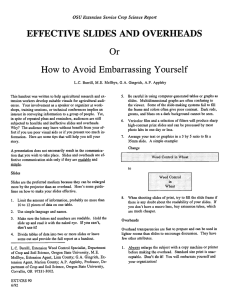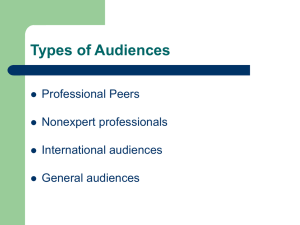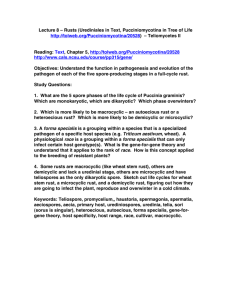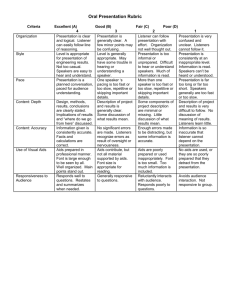Use Effective Visual Aids Don't Use Them At All Or
advertisement
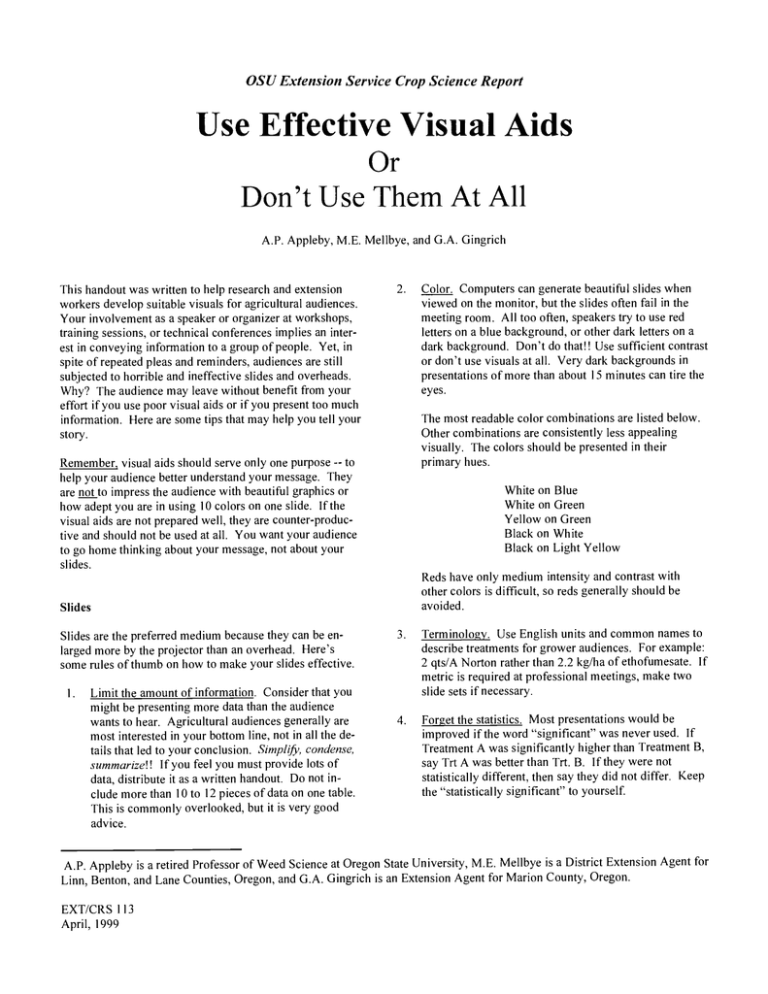
OSU Extension Service Crop Science Report Use Effective Visual Aids Or Don't Use Them At All A.P. Appleby, M.E. Mellbye, and G.A. Gingrich This handout was written to help research and extension workers develop suitable visuals for agricultural audiences. Your involvement as a speaker or organizer at workshops, training sessions, or technical conferences implies an interest in conveying information to a group of people. Yet, in spite of repeated pleas and reminders, audiences are still subjected to horrible and ineffective slides and overheads. Why? The audience may leave without benefit from your effort if you use poor visual aids or if you present too much information. Here are some tips that may help you tell your story. 2. eyes. The most readable color combinations are listed below. Other combinations are consistently less appealing visually. The colors should be presented in their primary hues. Remember, visual aids should serve only one purpose -- to help your audience better understand your message. They are not to impress the audience with beautiful graphics or how adept you are in using 10 colors on one slide. If the visual aids are not prepared well, they are counter-productive and should not be used at all. You want your audience to go home thinking about your message, not about your slides. White on Blue White on Green Yellow on Green Black on White Black on Light Yellow Reds have only medium intensity and contrast with other colors is difficult, so reds generally should be avoided. Slides Slides are the preferred medium because they can be enlarged more by the projector than an overhead. Here's some rules of thumb on how to make your slides effective. 1. Color. Computers can generate beautiful slides when viewed on the monitor, but the slides often fail in the meeting room. All too often, speakers try to use red letters on a blue background, or other dark letters on a dark background. Don't do that!! Use sufficient contrast or don't use visuals at all. Very dark backgrounds in presentations of more than about 15 minutes can tire the Limit the amount of information. Consider that you might be presenting more data than the audience wants to hear. Agricultural audiences generally are most interested in your bottom line, not in all the details that led to your conclusion. Simplify, condense, summarize!! If you feel you must provide lots of data, distribute it as a written handout. Do not include more than 10 to 12 pieces of data on one table. This is commonly overlooked, but it is very good advice. 3. Terminology. Use English units and common names to describe treatments for grower audiences. For example: 2 qts/A Norton rather than 2.2 kg/ha of ethofumesate. If metric is required at professional meetings, make two slide sets if necessary. 4. Forget the statistics. Most presentations would be improved if the word "significant" was never used. If Treatment A was significantly higher than Treatment B, say Trt A was better than Trt. B. If they were not statistically different, then say they did not differ. Keep the "statistically significant" to yourself. A.P. Appleby is a retired Professor of Weed Science at Oregon State University, M.E. Mellbye is a District Extension Agent for Linn, Benton, and Lane Counties, Oregon, and G.A. Gingrich is an Extension Agent for Marion County, Oregon. EXT/CRS 113 April, 1999 5. Round to whole numbers. Following is an example of how to improve a data table. Do not include decimal places. 8. Time Per Slide. This depends entirely on the slide or overhead. Some need 5 seconds, others can be discussed for a minute or longer. A common mistake is spending too little time on key visual aids. Remember that the audience has never seen that slide before. However, don't dwell on a slide longer than necessary. 9. Use photos. Intersperse data slides with appropriate photos or illustrations of materials, events, locations, or even some (clean) humor or philosophy. 10. Readability. Words with upper and lower case letters are more readable than those done in capitals. Use bold type, not capitals, italics, or stylized letters. For example: Stem Rust is better than STEM RUST, stem rust, or Stem Rust. 11. Words and lines. Limit the title slide to ten words. Use five or less lines per slide. 12. Conclusion slide. Use a conclusion slide to nail down your take-home message. Keep it simple. 13. Start preparing early. Too many slides are poor because they were prepared a day or two before the meeting with no time to make corrections. No time is saved by procrastinating. 14. COMMUNICATION IS THE GOAL!! [Poor] The Effect of Fungicides and Cerone on Septoria and Yields in Three Varieties of Winter Wheat. Treatment Variety Malcolm Hill 81 Stephens (bu/acre) Check Cerone Tilt Tilt + Cerone LSD (0.5) 140.1b 129.7c 163.5a 159.9a 135.6a 130.2c 134.0ab 133.5abc 3.4 142.3b 140.0b 158.1a 156.8a 4.3 8.5 [Betted Cerone and Fungicides for Septoria on Wheat Hill 81 Malcolm Stephens (bu/a) Control Cerone Tilt Tilt + Cerone 6. 140 130 164 160 136 130 134 134 142 140 158 157 Use the correct ratio. Arrange your text or graphics in a 3 by 5 ratio to fit a 35 mm slide. A simple example: Overheads Overhead transparencies are fast to prepare and can be used in lighter rooms than can slides, which can encourage discussion. They have few other attributes. 1. Always enlarge typed copy with a copy machine or printer before making the overhead. Standard size print is unacceptable. Don't do it!! You will embarrass yourself and your organization! 2. Large print with colored felt pens will produce readable overheads that are far superior to small block type. 3. Never make overheads of large tables and graphs. The print cannot be seen. Never use a font size less than 20, larger is better, especially in a large room You are trying to communicate, so print should be easily read from the back of the room. If the audience has to squint, the print is too small. Try them out in a long room before the meeting. Enlarge them with a copier if necessary. Change Weed Control in Wheat to Weed Control in Wheat 7. Font size. Make sure that the font size of the print you select can be seen by the audience. Often, a graph can be read but the print cannot. Use a minimum font size of 20, larger if possible. Never use a slide that forces you to say, "I know you can't see this, but....." Make the letters and numbers bigger.
